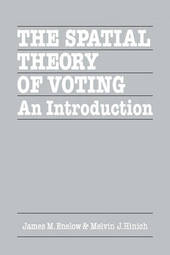
|
The Spatial Theory of Voting: An Introduction
Paperback / softback
Main Details
| Title |
The Spatial Theory of Voting: An Introduction
|
| Authors and Contributors |
By (author) James M. Enelow
|
|
By (author) Melvin J. Hinich
|
| Physical Properties |
| Format:Paperback / softback | | Pages:256 | | Dimensions(mm): Height 229,Width 152 |
|
| ISBN/Barcode |
9780521275156
|
| Classifications | Dewey:324.9 |
|---|
| Audience | | Tertiary Education (US: College) | |
|---|
| Illustrations |
Worked examples or Exercises
|
|
Publishing Details |
| Publisher |
Cambridge University Press
|
| Imprint |
Cambridge University Press
|
| Publication Date |
27 April 1984 |
| Publication Country |
United Kingdom
|
Description
This book provides an introduction to an important approach to the study of voting and elections: the spatial theory of voting. In contrast to the social-psychological approach to studying voting behaviour, the spatial theory of voting is premised on the idea of self-interested choice. Voters cast votes on the basis of their evaluation of the candidates or policy alternatives competing for their vote. Candidates fashion their appeals to the voters in an effort to win votes. The spatial theory provides explicit definitions for these behavioural assumptions to determines the form that self-interested behaviour will take. The consequences of this behaviour for the type of candidate or policy that voters will select is the major focus of the theory. There is a twofold purpose to this work. The first is to provide an elementary but rigourous introduction to an important body of political science research. The second is to design and test a spatial theory of elections that provides insights into the nature of election contests. The book will appeal to a wide audience, since the mathematics is kept to an accessible level.
|